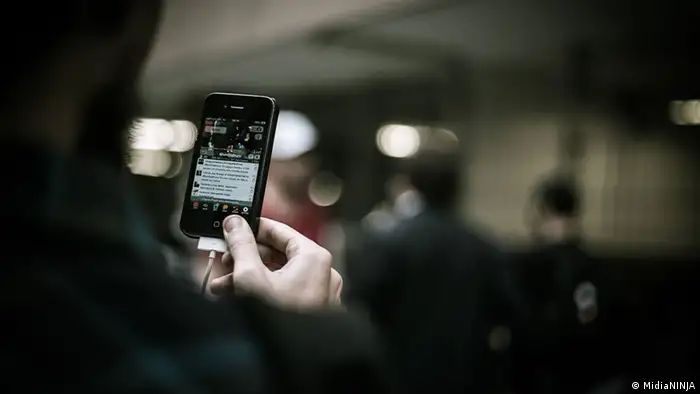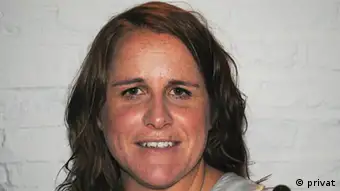DW AKADEMIE
'Journalism is full of gray areas'
Eyewitness media has played a major role in breaking news stories. Digital expert Claire Wardle explains the implications for journalistic practice and the ethical limitations around verification.
2015 has seen a number of breaking news events where content posted by eyewitnesses to social media became a story in its own right. Claire Wardle, Research Director at Columbia University's Tow Center for Digital Journalism, is a leading expert on user-generated content. She has been investigating the impact this trend is having on journalists, newsrooms and eyewitnesses. The verification of user-generated content and putting it in context are becoming ever more important, she says.
What’s the first thing a journalist has to keep in mind when using eyewitness media?
What’s the first thing a journalist has to keep in mind when using eyewitness media?
Claire Wardle: Journalists need to remain skeptical about everything they see. They shouldn't believe anything until they do all of the necessary checks.
What are the ethical limitations regarding eyewitness media?
Consent is the biggest issue. You need to be asking the following questions: How will broadcasting or using the eyewitness media impact the person who filmed it, or the people captured in the footage? Is it safe for them to be publicized? Are you giving the content creator credit? Do they want to be connected to capturing the footage?
Obviously, responsible journalism in crisis situations is key. What’s the responsibility of the public when posting information on social media?
Obviously, responsible journalism in crisis situations is key. What’s the responsibility of the public when posting information on social media?
Anyone posting information should first think about whether it is true. Circulating rumors can be incredibly dangerous. Secondly, before sharing information a person should think about how it could impact others. Just because someone shared something on social media, that doesn't mean they want it shared beyond their immediate circle of contacts.
Publishing vital information vs. potentially placing your source at risk: How should this gray area be dealt with? What role do newsrooms play in this?
Publishing vital information vs. potentially placing your source at risk: How should this gray area be dealt with? What role do newsrooms play in this?
Editors always have to consider these questions. Journalism is full of gray areas. Newsrooms are often rushing to be first with the information, and therefore don't give the necessary ethical thought to what publishing something will mean. Yes, journalism is a competitive space but we live in a time when news organizations have to act in a way that will make their readers trust them. Publishing false information or content that places people in danger or invades their privacy erodes trust.
In our digital age, verifying information has become much more difficult than finding and aggregating information. In what way is digital journalism changing the role of journalists?
In our digital age, verifying information has become much more difficult than finding and aggregating information. In what way is digital journalism changing the role of journalists?
Nowadays, breaking news journalism is much more about verification and providing context. When your audience can access the same information as journalists, it's imperative that news organizations guide their audience through the content - what is true and why does it matter.
A lot is happening in terms of technical verification tools and apps. How do you keep track?
A lot is happening in terms of technical verification tools and apps. How do you keep track?
The people who really take verification seriously are actually small in number. So I follow them on Twitter. All the members of First Draft coalition are a good start. Bellingcat is an incredible resource for learning about new tools and techniques.
Digital journalism in 2030 – what's your vision?
Digital journalism in 2030 – what's your vision?
Very large parts of journalism will be automated but that will leave space for incredible long-form investigative journalism which people will pay for!
You're a researcher - how did you get involved in the field of digital journalism? What is the attraction?
You're a researcher - how did you get involved in the field of digital journalism? What is the attraction?
I've always loved journalism but I have never been a journalist. My PhD was from the Annenberg School for Communication in journalism studies but it was a historical analysis of newspapers (not very digital). I then taught at the Cardiff School of Journalism but it was very theoretical. In 2007, I was looking for my next research project, and I realised I had become obsessed with the people who would email or text the BBC during the breakfast show. I wanted to know who they were and what motivated them to connect with the BBC. That started my love affair with 'user-generated content'. I spent over a year working with the BBC on a large project to understand audience contributions and from that, they invited me to design a new training course on UGC, social media and verification. This was a crucial year in digital journalism and I feel so lucky I could have a year to just play and learn. I left academia and spent the next six years in newsrooms around the world offering consultancy and training.
Claire Wardle has led two research projects investigating how user-generated content is handled by news organizations. In 2009, she developed a Social Newsgathering and Verification training program at BBC News. She was also the Director of News Services for Storyful, and Senior Social Media Office at the UN's refugee agency, UNHCR. In October 2014, Wardle co-founded Eyewitness Media Hub, a non-profit initiative committed to providing content creators and publishers with continuing research and resources.
This interview has been edited for brevity and clarity.
DW recommends
- Date 14.12.2015
- Author Charlotte Hauswedell
- Print Print this page
- Permalink https://p.dw.com/p/1HMvH
- Date 14.12.2015
- Author Charlotte Hauswedell
- Print Print this page
- Permalink https://p.dw.com/p/1HMvH


